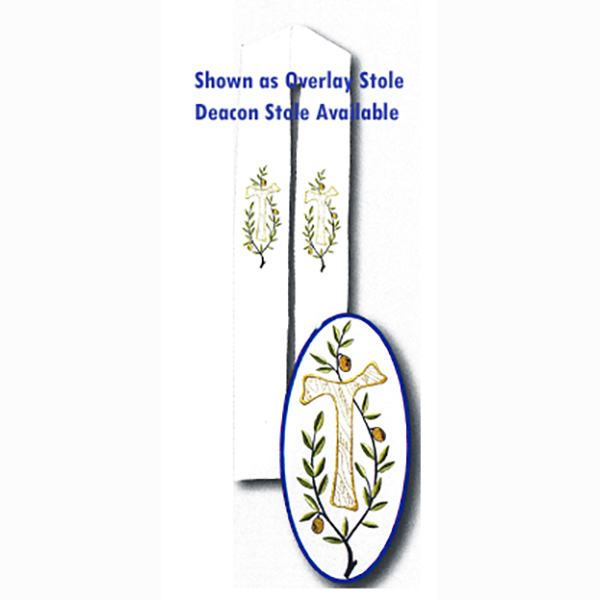Beau Veste Tau Cross & Olive Branch Deacon Stole 10-772 is a Deacon Stole with the Franciscan Tau Cross embroidered on each side.
Shown here as overlay stole - will come as Deacon Style Stole
These stoles are beautifully raised multicolored Swiss schiffli embroidery. Lined and interlined texturized fortrel polyester.
Choose Color: Each Vestment is available in all Liturgical Colors: Pure White, Off White, Red, Purple, Kelly Green, Hunter Green, Blue, Rose Pink
These stoles can have custom embroidery
Beau Veste Tau Cross & Olive Branch Deacon Stole 10-772
Meaning of the Olive Branch:
The Olive Branch, a symbol of peace, also symbolizes deliverance from anxiety, i.e. the dove returning to Noah's Ark with an olive branch in its beak indicating water is subsiding and land is near - deliverance. So the Olive Branch symbolizes deliverance from anxiety, from hardships in this life, and peace, especially peace with God in Heaven.
Meaning of the Tau Cross & Short History of the Tau Cross:
The Tau is a cross shaped like the Greek letter “T”. It is called the Tau Cross, Old Testament Cross, Advent Cross, St. Anthony’s Cross, St. Francis of Assisi Cross.
Tau is the last letter of the Hebrew alphabet and was used symbolically in the Old Testament. It was spoken of in the Book of Ezekiel: “The Lord said to him, ‘Go through the city, through Jerusalem, and put a mark upon the foreheads of the men who sigh and groan over the abominations… (Ez. 9:4). The Tau is the sign placed upon the foreheads of the poor of Israel, it saves them from extermination. The Tau is said to be the shape of the cross formed by the blood on their doorposts to save the first born. Also, it is believed to be the shape of cross on which Moses lifted the bronze serpent. Likewise, it is sometimes call an Anticipatory Cross, from John 3:14 “Just as Moses lifted up the snake in the wilderness, so the Son of Man must be lifted up”
The Tau was used by the early Christians, for these reasons:
- Being the last letter of the Hebrew alphabet, it prophesied the Last Day and had the same function as the Greek letter Omega as it appears in the Book of Revelation: “I am the Alpha and the Omega, the beginning and the end. To the thirsty I will give water without price from the fountain of the water of life” (Rev. 21:6;22:13).
- The Christians adopted the Tau because its form reminded them of the Cross on which Christ died for the salvation of the world.
- The Tau is not an obvious form of the cross, and they used it so non-Christians would not recognize it, as the Christians could be persecuted for being part of an illegal movement.
What is the Tau a sign of?
The Tau is a sign of Christian devotion, a sign of the commitment of one’s life to following the crucified Christ, as it is the Cross that held Christ our Savior.
The Tau is a sign of the awareness of a Christian, the Lord’s redeemed, a child of God, the unblemished, those who trust Him, who has escaped danger, It is a sign of powerful protection against evil (Ez.9,6).
The Tau is a sign willed by God for us, it is a divine privilege (Rev.9:4; Rev.7:1-4; Rev.14:1).
The Tau is a sign that reminds us that we must be strong in time of trial, ready to obey God the Father, and docile in submission, as Jesus was strong in time of trial, obedient and docile before God the Father.
The Tau Cross and St. Francis of Assisi
Because of the Tau’s resemblance to the cross, the Tau Cross was very dear to St. Francis of Assisi, it occupied an important place in his life as well as his gestures. In him the ancient prophetic sign was actualized and regained its saving power expressing the beatitude of poverty, an essential element of the Franciscan way of life.
“Whenever necessity or charity required, St. Francis marked with this seal the letters he sent” (FF 980); “He began all of his actions with it” (FF 1347). The Tau was a sign dear to St. Francis, his seal, the sign of a spiritual conviction that the salvation of everyone is only in the Cross of Christ.



